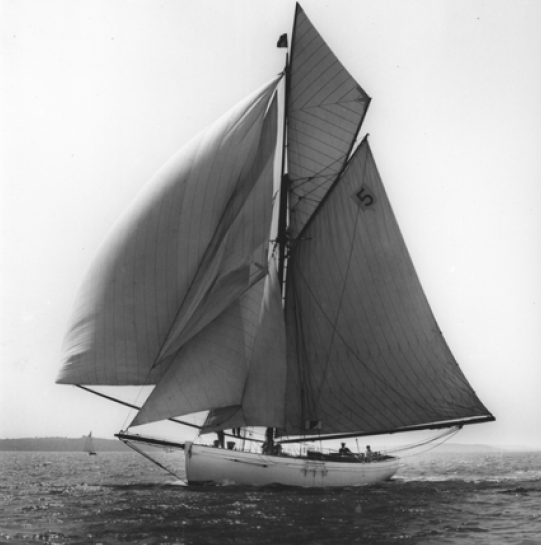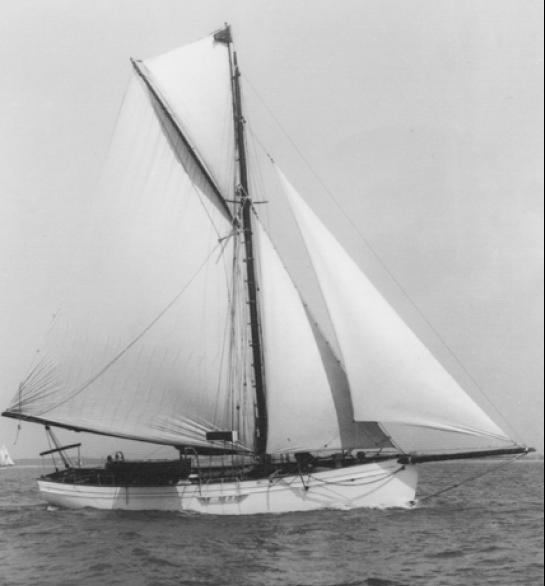
Sail Number: 5
Type: Gaff Cutter
LOA:
LOD: 47ft 6in / 14.47m – LWL: 44’1″ / 13.43m – Beam: 12’10” / 3.91m – Draft: 7’0″ / 2.13m – Ballast Keel 4.78 tons – Internal Ballast 8 tons – Thames Measurement 30 tons – Sail Area: 1374 / 127.64 m2 – Original Name: Betty – Original Owner: Charles Hellyer of Brixham – Year Launched: 1909 – Designed by: Albert Strange – Design Number: 96 – Built by: Stow & Son of Shoreham under Lloyd’s survey – Hull Material: Wood
Historical Synopsis
Tally Ho is a 107-year old English sailing yacht designed by Albert Strange in 1909. A gaff cutter, 47’ on deck, she is a well-known and an important historic vessel. She was built by Stow & Son of Shoreham under Lloyd’s survey to the highest class. But after many adventures and attempts to save her, Tally Ho was left unused for decades in Brookings Harbor, a remote Oregon port. In 2018, Leo Sampson Goolden, a young British wooden boat builder and professional sailor, bought Tally Ho and moved her to Sequim, Washington on the Olympic Peninsula. He is in the midsts of a major rebuild project from the keel up and is documenting his efforts in a Web series on YouTube. Leo’s goal is to complete the rebuild within the next 18 to 24 months and sail a fully restored Tally Ho back to the UK.
Historical:
At 47ft 6in loa and 30 tons tm, Betty was the largest transom-sterned boat designed by Albert Strange. She was built for Charles Hellyer of Brixham, who had fishing interests in that port, as well as in Hull, where he owned one of the first steam trawler fleets, and was a member of the Humber Yawl Club. Betty was built by the well-known and reputable yard of Stow & Sons at Shoreham, Sussex to Lloyd’s highest class. The ’midship section drawing shows the hull was to be planked in American elm below the waterline, with teak above. The commentary which accompanied the publication of the design in The Yachting Monthly in 1910 remarks that Hellyer required a yacht in which he could ‘cruise in comfort whilst indulging in deep-sea fishing’. This explains the barrel windlass forward of the mast and perhaps the unusually clear flush deck. It continues:
“The transom stern, rather unusual in a yacht of this tonnage, was adopted in deference to the wishes of the owner, in order that she might lie in the crowded harbour of Brixham in the smallest possible space.”
The boat has had a colourful career. When Hellyer commissioned Strange to design the larger Betty II of 50ft waterline in 1913 Betty was sold, and in 1927 passed into the ownership of Hugh Grosvenor, Lord Stalbridge, who renamed her Tally Ho. The photograph by Beken of Cowes shows her at this period under racing canvas, with the short pole mast changed to a taller fidded topmast rig, and sail area increased by some 400 sq.ft. or about 20%. Her celebrated win of the 1927 Fastnet Race in storm conditions is related later. Alf Loomis, crewing on the Alden schooner La Goleta, wrote of it:
“At the time, this contest between Tally Ho and La Goleta was characterised as the hardest fight between two yachts that had ever been sailed in English waters over so long a cåourse and under such heavy weather conditions.”

There is less recorded of Tally Ho in the following decades, although the delightful photographs from the Clark family album show her at the outset of a year-long transatlantic cruise in 1958. It seems that she completed more than one trans-Atlantic trip after the Second World War, whilst still based in the Southampton area. Then, in 1967, New Zealander Jim Louden set out in Tally Ho from England heading for home, via the Panama Canal. He paused to charter for a few months in the Caribbean and then sailed on single-handed to Rarotonga, in the Pacific, which he reached in July 1968. Here he was offered a charter to fetch 20 tons of copra from the island of Manuae (Hervey Islands), 120 miles to the northeast. With a young lad as crew, he reached the offing during darkness and hove to waiting for dawn. As they slept, the current carried the yacht down onto the island, where the surf lifted and drove her onto the coral reef and stove in her port side amidships.
She was eventually dragged off the reef, after seven tons of lead ballast had been removed from her bilge and her cabin filled with empty oil drums. As she came off, she rolled over and was dismasted, also losing her rudder and bowsprit. But the drums kept her floating just awash and, in that condition, she was towed the 120 miles back to Rarotonga, something of a tribute to the strength of her original deck construction. In Rarotonga she was rebuilt over a period of years, during which time she changed hands, and eventually she found her way, via Tahiti and Hawaii, to the west coast of the United States. There, with aft wheelhouse and twin trolling poles rigged on the mast, she went to work periodically, under the name Escape, fishing for tuna and salmon out of Brookings Harbor, Oregon. During this ownership, in the 10 years between 1977 and 1987, Dave Olson sailed some 20,000 miles in her, twice to the Marquesas, to Tahiti, a frequent visitor to Hawaii, even Pitcairn.
At this time she was still in remarkably good condition for a boat of her age and usage. But when Dave Olson wanted to move on, a new owner could not be found and she languished in Brookings Harbor for some years. It was during this period that the Albert Strange Association became aware of Tally Ho, and that she was potentially running into trouble. In 2008 the Port of Brookings sold her at auction to a local artist, fisherman and shipwright, Manuel Lopez, who formed a charitable foundation and set out to restore her, with the idea of making her a show-piece for Brookings. Manuel did extensive work on the hull, but sadly died in early 2010 without having got her back in the water.
With the loss of Manuel’s driving force, Tally Ho found herself again ‘in limbo’, with storage fees accumulating which the charitable foundation had no means to pay. By late 2012 the Port was preparing to foreclose on her again, and there was a real danger that she would have to be broken up. It seemed to be in the nick of time that the Association, in a renewed effort, contacted the Port Manager, and a plan of action was initiated. With the full and generous cooperation of the Port Manager and members of the foundation that Manuel Lopez had set up, a plan was agreed. The Port offered to prepare a piece of ground and move Tally Ho away from the busy working area she had occupied, and to waive overdue charges. The Association formed a wholly owned UK limited company for the sole purpose of holding title to the boat, and through which it would pay storage fees at a very reasonable rate.
Pat Kellis, a retired waterman in Brookings, who lives in the vicinity, undertook to thoroughly shore and cover the boat to protect her from the ravages of summer and winter weather. The ASA embarked on a campaign to raise awareness of Tally Ho, and locate that person, or perhaps syndicate, with the passion and resources sufficient to get her back on the water. Jeff Rutherford, a very experienced yacht restoration specialist from Richmond, California, kindly inspected her and gave us his preliminary assessment of her condition and a projection of possible restoration costs.
Throughout her long life of cruising, racing, fishing, injury, repair and neglect, she has retained her all-important shape and not inconsiderable degree of structural integrity—a great testament to the quality and strength of her original construction.
Provenance (The Wall of Remembrance – The Owners, Crew & Notable Guest):
Owner/Guardian: (1909 – 1912) – Charles Hellyer of Brixham (Betty)
Owner/Guardian: (1912) – Lord Stalbridge (Tally Ho)
Owner/Guardian: (1967) – Jim Louden
Owner/Guardian: (1977 – 1987) – Dave Olson
Owner/Guardian: (2008 – 2010) – Manuel Lopez
Owner/Guardian: (2012) – Manuel Lopez Foundation/ASA (Albert Strange Association)
Owner/Guardian: (2018) – Leo Goolden
Comment:
Tally Ho looks deceptively small in the drawings. Had she the counter stern and more raked bow that usually balanced it at this period, her overall length on this waterline would have been something like 60ft, and indeed, her accommodation and performance are what one would more commonly expect from a yacht of that length.
Leo’s Evaluation
When Leo went to look at her he was astounded by the amount of work to do. But he was also surprised to find that the planks were mostly in very good condition, and that the huge keel timber was solid teak.
Current Restoration
Connecting with the Washington state traditional sailing community, Leo was very generously offered the use of a piece of land and a workshop for the project. The Albert Strange Association, (who eventually sold the boat to Leo for just £1), offered to contribute towards the cost of moving her from. Adding his own funds to pay the balance of the moving costs, Leo had Tally Ho shipped 600 miles to Sequim, WA. He constructed a boat shed to enclose her, started recruiting volunteer help, cleaned up and organize the workshop, provisioned the loft as his living space, and installed a small kitchen to cook his his meals. He was off.
Leo Goolden’s website is http://sampsonboat.co.uk/support-tally-ho/
Tally Ho website… https://www.yachttallyho.com
A lot more info and photos… https://www.yachttallyho.com/index.php/about-tally-ho
Comments
Russ Wetzel – December 17, 2022
Tally Ho’s hull and deck have been completely re-done and the entire project has moved to Port Townsend, WA as of July, 2021. check out the progress. Link above.
